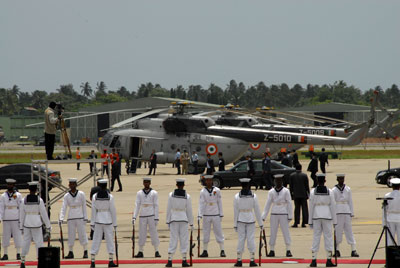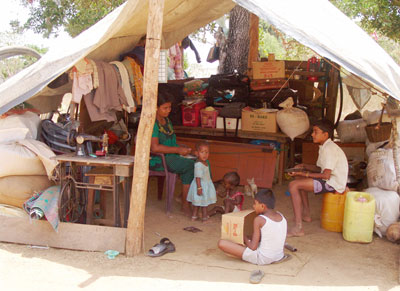Sri Lanka's most fortified event in the new millennium, the summit of South Asian leaders in Colombo, ends today. Not only 12,000 police officers and 7,000 troops crowded the City of Colombo and the immediate suburbs to ensure security. There were additional measures from participating countries too. Preventing possible attacks by Tiger guerrillas was the primary aim though other threat perceptions figured to a much lesser degree.

Fifty Naval troops formed a “street line” to greet India’s Prime Minister, Manmohan Singh, who arrived at the Bandaranaike International Airport on Friday afternoon for the SAARC summit. After walking past them, he boarded a waiting limousine for the short drive to an Mi-17 VIP transport helicopter for his flight to Colombo. Picture shows him being driven to the helicopter. Photo: Sanka Vidanagama. |
|
Sharing Sri Lanka's concern over guerrilla threats was neighbouring India. New Delhi's senior intelligence officials as well as those responsible for close protection for Prime Minister Manmohan Singh and his entourage, went through every conceivable detail with their Sri Lankan counterparts. This was during visits to Colombo ahead of yesterday's South Asian Association for Regional Co-operation (SAARC) summit.
It can now be revealed that their concerns were among the factors that helped in finalising locations for some events. An example was plans to use the Mount Lavinia Hotel as the retreat for South Asian leaders. There were concerns after a string of incidents around the Mount Lavinia area. On April 25, a claymore mine explosion inside a bus left 27 civilians killed. On May 26, nine commuters were killed when a bomb exploded inside a train at the Dehiwala railway station. On June 4, an explosion caused damage to the rail track between Dehiwala and Wellawatte. Police blamed the Tiger guerrillas for all these incidents.
It led to the selection of an unlikely location, the Parliamentary complex at Kotte-Sri Jayawardenapura as the retreat for SAARC leaders. The setting, surrounded by the Diyawanna Oya, they believed, provided better protection. SAARC leaders, their Foreign Ministers, Foreign Secretaries, SAARC Secretaries General, the outgoing and the new incumbent, will meet today for lunch and informal talks. Another example arose from the Tiger guerrillas directing automatic rifle fire at an Air Force Bell helicopter in the skies over Kanjikudichchiaru. The helicopter, which was a "chaser" or escort to the Presidential helicopter, had flown from Arugam Bay to the Air Force base in Ampara for refuelling on July 1. The incident took place when it was returning to Arugam Bay. President Rajapaksa had flown there to declare open a new bridge constructed with United States aid.
The presence of two Indian warships in the deep seas outside Colombo was meant to cope with these as well as other perceived threats. Anchored in the deep seas off the Galle Face green were two Indian warships. One was the 6,700 ton general purpose destroyer INS Mysore that is equipped to meet any air, surface and under water threats. This multi-role battleship is equipped with long range anti-submarine missiles, surface-to-air missiles, torpedos, guns, rockets and Sea King helicopters.
Also anchored nearby was the 5000 ton destroyer INS Ranvir. Among the bristling armaments on board were surface-to-surface missiles (SSMs) with a range of 110 kilometres. Also on board is a Russian built KA 28 helicopter with anti-submarine weaponry. It has an extended endurance of over five hours. A complement of 35 officers and 320 men are assigned to this warship.
The presence of the two warships was in marked contrast to July 1987 when the then President, the late J.R. Jayewardene signed the Indo-Sri Lanka Accord with late Rajiv Gandhi, then Indian Prime Minister. Then, two frigates of the Indian Navy were anchored within visible distance off the Galle Face green. Of course, that measure was prompted by fears of threats emanating from violence in the south against the accord.
A security source said help from the two warships in the event of an emergency would have been only few moments away. "Their on board helicopters could have landed on the Galle Face green within minutes in the event of an emergency. Indian Prime Minister, Manmohan Singh was staying at the Taj Samudra and the Indian media contingent was accommodated at the Galle Face hotel," the source who did not wish to be identified said. They are not officially authorised to speak.

Heavy fighting in the Mannar sector have forced civilians to re-locate. Here is a family from Mallavi that have moved into a temporary shelter with whatever belongings they could carry. |
|
The operations room in INS Mysore closely monitored Friday afternoon's arrival of Premier Singh at the Bandaranaike International Airport and his subsequent flight in an IAF Mi-17 helicopter to Colombo, the source said. Besides the Mi-17 helicopter for Premier Singh's use, India had also made available another to the Government for use by visiting VIPs. The same source said on the ground only proximate security was the responsibility of his personal protection group. Specialised units of the Security Forces and the Police covered the outer ring.
This is the first time in a decade that an Indian Prime Minister visited Sri Lanka. The last was in July 1998 when then Prime Minister Atal Bihari Vajpayee visited Colombo. Earlier, then Indian Premier Rajiv Gandhi visited Colombo in July 1987 to sign the Indo-Lanka Accord. On that occasion a naval rating attempted to assault Mr. Gandhi with a rifle when he was inspecting a guard of honour outside the Janadipathi Mandiraya (President's House). This time, however, there was no guard of honour for SAARC leaders. The Sri Lanka Navy formed a "street line" of 50 sailors when Premier Singh arrived at the BIA. Similarly, others received "street line" reception from Army or the Air Force.
Only three SAARC leaders - Indian Prime Minister Manmohan Singh, Afghanistan President Hamid Karzai and Pakistan Prime Minister, Yousaf Raza Gilani arrived by special aircraft. The remaining four arrived in Colombo in commercial flights. They were Nepal Prime Minister Girija Prasad Koirala (Sri Lankan Airlnes), Bhutan Prime Minister Jigme Lynchchin Y. Thinley (Cathay Pacific) and Chief Advisor to the Government of Bangladesh Fakhruddin Ahmed (Singapore Airlines) and Maldivian President Maumoon Abdul Gayoom (Sri Lankan Airlines).
Security arrangements at the airport were the responsibility of the Prime Minister's Security Division (PMSD) whilst the Presidential Security Division (PSD) was tasked with security at the Bandaranaike Memorial International Conference Hall (BMICH), the conference venue. At yesterday’s inaugural sessions of the summit jammers were used to block mobile telephone conversations. This was part of stringent security measures at the conference venue.
The tighter security arrangements for the SAARC events in Colombo and suburbs came notwithstanding the offer of a "unilateral ceasefire" by the Tiger guerrillas. The Liberation Tigers of Tamil Eelam (LTTE) on July 22 declared it would observe this "unilateral ceasefire" from July 26 to August 4. A statement said this was to "give our co-operation for the success of the summit." The LTTE, however, warned that if the Security Forces, "disrespecting our goodwill gesture of our people and our nation, carry out any offensives, our movement will be forced to take defensive actions." The Government rejected the offer.
Hence, there was no ceasefire in force as far as Sri Lanka's defence and security establishment were concerned. Security Forces continued their offensive operations to seize more guerrilla-dominated areas in the Wanni throughout this week. Air Force bombers continued to pound several guerrilla targets. Intense ground battles continued in the Mannar sector. Fighting was severe on Friday, particularly in the general area west of Vavunikulam.
This took place when troops fought bitter battles in a location south of Mallavi, once a hub of Tiger guerrillas. Their nerve centre of operations was in this village when Kilinochchi was under Security Forces control. It came about when they were making a strong thrust to gain control of this area and proceed to re-capture Thunnukai. Similar battles were also fought in the same region early this week. For reasons now obvious details of the incidents cannot be discussed.
Troops also continued their advance in the sector north of Weli Oya. The heavy fighting forced more civilians in the villages in and around Mallavi and Tunnukkai to flee their homes with whatever belongings they could carry. Some of them are living in temporary shelters. There was relatively less guerrilla resistance to a column of troops advancing along the western coast north of the recently captured village of Iluppaikaddavai. Last week they took control of a guerrilla base in this area. They moved into the nearby village of Vilaankulam before nightfall yesterday. Last evening, Army sources in Mannar said, troops had trapped a group of guerrillas including a local leader in an area along their advance.
The Government seized the opportunity of the SAARC to provide the foreign media covering the events a briefing on the ongoing military campaign against guerrillas. A team led by Defence Spokesman Keheliya Rambukwella turned up at the Trans Asia hotel where most foreign media were located. There, officers of the Army, Navy, Air Force and Police were on hand to brief them on various aspects. Though a turnout of 200 were expected, only about 30 media personnel had turned up.
Director of Operations of the Army, Brigadier Udaya Perera, briefed them on the ongoing operations. Major General L.R.B. Marks, General Officer Commanding the Army's 51 Division headquartered in Jaffna, gave a briefing on the “normalcy” prevailing in the peninsula. Time constraints prevented two others from giving presentations. They were Major General Mohanti Peiris on human rights aspects and Nimal Lewke, DIG on security in Colombo. Mr. Lewke was a former Commandant of the Police Special Task Force and is now in charge of the Police Field Force Headquarters.
The ten-day Tiger guerrilla "unilateral ceasefire" which ends tomorrow, in the real sense, did not exist. The Army, which did not accept it, continued their offensive operations to re-capture more guerrilla territory. This is both in the Mannar and Weli Oya sectors. Hence, the guerrillas engaged the troops that were advancing. This prompted some sections of the Government to claim that the guerrillas had violated their own "unilateral ceasefire." Firstly, such claims were hollow since the Government had rejected the ceasefire offer. Secondly, the offer of the "unilateral ceasefire," as the LTTE's statement said, was conditional upon their claim to take "defensive action" if Security Forces carried out offensives.
Thus, they would naturally take umbrage under the claim that their attacks were "defensive action." This is not withstanding instances during the “unilateral ceasefire” where they had carried out surprise attacks.
Therefore, in reality, despite the guerrilla assertions, there was indeed no "unilateral ceasefire" in force. Ceasefire or not, Sri Lanka's defence and security establishment were conscious that the guerrillas would not resort to any attacks in Colombo and suburbs during the period of the SAARC conference. Yet, they did not take chances and intensified security. Tomorrow (August 4) the ten-day ceasefire will come to an end. The Security Forces are determined to move into the guerrilla strongholds in the Mullaitivu and the Kilinochchi districts.
In fact the Ministry of Defence has said that troops have entered the Kilinochchi district at a secret location. This could not be independently verified. The battles in the coming days and weeks would naturally intensify. Thus, the likelihood of a new and a fiercer phase in fighting will become inevitable with the troops now on the doorstep of guerrilla heartland.

|



